8 /10 1 Votes
71% Metacritic Producer(s) Noriaki Niino Programmer(s) Noboru Hidaka Initial release date 29 August 2013 Adapted from JoJo's Bizarre Adventure | 4.9/5 PlayStation®Store 71% GameFAQs Designer(s) Kenei Nakasha Artist(s) Yoshitaka Kinoshita | |||||||||||||||||||||||||||||||||
 | ||||||||||||||||||||||||||||||||||
Director(s) Hiroshi MatsuyamaKenei Nakasha Publisher Bandai Namco Entertainment Similar Bandai Namco Entertainment games, Fighting games | ||||||||||||||||||||||||||||||||||
Jojo s bizarre adventure all star battle review
JoJo's Bizarre Adventure: All Star Battle (ジョジョの奇妙な冒険 オールスターバトル, JoJo no Kimyō na Bōken Ōru Sutā Batoru) is a fighting game developed by CyberConnect2 and published by Namco Bandai Games for PlayStation 3. Based on Hirohiko Araki's long-running manga series JoJo's Bizarre Adventure, the game allows players to compete against each other using over 40 characters taken from all eight current story arcs. The game was released in Japan on August 29, 2013, and was released internationally in late April 2014.
Contents
- Jojo s bizarre adventure all star battle review
- Jojo s bizarre adventure all star battle ps3 first trailer part 1 2 3
- Gameplay
- Game modes
- Battle Styles
- Characters
- Stages
- Download content
- All Star Battle League
- Development
- Reception
- References
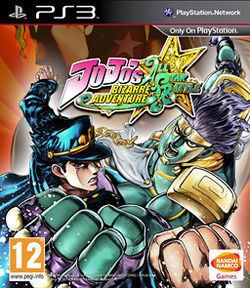
Jojo s bizarre adventure all star battle ps3 first trailer part 1 2 3
Gameplay
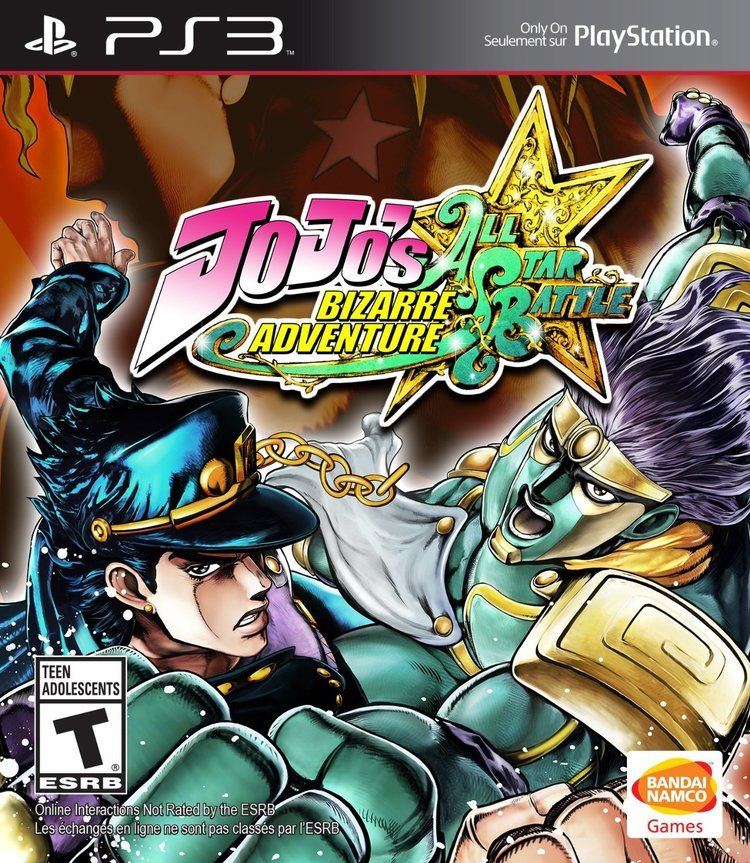
JoJo's Bizarre Adventure: All Star Battle is a 3D fighting game in which players can fight against each other using characters taken from all eight current story arcs from Hirohiko Araki's JoJo's Bizarre Adventure manga series (and one from a prior work by Araki), fighting in various locations taken from the manga. Like most fighting games, the aim is to defeat your opponent by draining their stamina gauge (HP is used in a certain game mode) with various attacks and special techniques. The player wins a round by draining all of their opponent's stamina, or by possessing more stamina than their opponent when time runs out. Gameplay uses five main buttons; light, medium, and heavy attacks, a dodge button, and a "Style" button. Along with the ability to use various special attacks and techniques with different directional inputs, each character possesses a Battle Style, allowing them to utilize additional moves with the "Style" button. Styles fall into one of six main categories: Ripple, Vampirism, Mode, Stand, Mounted, and Baoh Armed Phenomenon, each utilizing different abilities when the Style button is pressed. For example, Ripple users can use the power of the Ripple to augment the strength of their attacks, whilst Stand users can summon out their Stand, giving them additional move types whilst also making themselves more vulnerable.
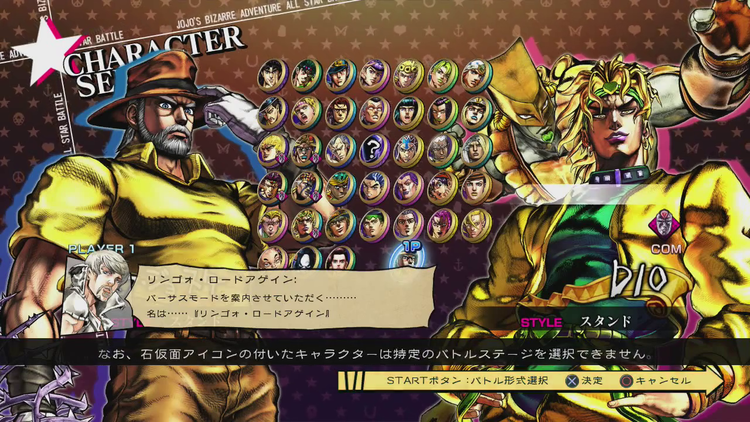
Attacking and receiving damage fills up a player's Heart Heat Gauge (ハートヒートゲージ, Hāto Hīto Gēji) which, when filled to either one or two levels, allows players to perform powerful Heart Heat Attacks (ハートヒートアタック, Hāto Hīto Attakku, HHA) or Great Heat Attacks (グレートヒートアタック, Gurēto Hīto Attaku, GHA), depending on how much their gauge is filled and which multiple button input is chosen. Players can decrease their opponent's Heart Heat Gauge by using taunts when they are knocked down. Players can also use Flash Cancels to deplete their own Heart Heat Gauge to cancel their current combo attack and chain into a new one. The Heart Heat Gauge is also used in some Battle Styles and certain special techniques. Rush Mode (ラッシュモード, Rasshu Mōdo), similar to the "Blazing Fists Match" system of Capcom's 1998 fighting game based on the series, occurs when two "Rush" attacks collide with each other, beginning a button mashing minigame. When a character's Stamina is low, the character enters one of two modes to turn the tide of the match: Rumble Mode (ゴゴゴモード, Gogogo Mōdo), which increases the character's attack strength and Heart Heat Gauge restoration, and Resolve Mode (覚悟モード, Kakugo Mōdo), which in addition to the bonuses from Rumble Mode adds a temporary invincible armor as well. Novice players can use the Easy Beat (イージービート, Ījī Bīto) system, which allows them to more easily string together combos and techniques by using only a single button. Along with the stamina gauge, players also have a Guard Gauge (ガードゲージ, Gādo Gēji) which depletes when they block attacks, causing them to become vulnerable if it is completely drained in a Guard Crush (ガードクラッシュ, Gādo Kurasshu). The Guard Gauge is also depleted by Stylish Evades, special dodges that when executed properly make the character perform one of their iconic poses from the manga.
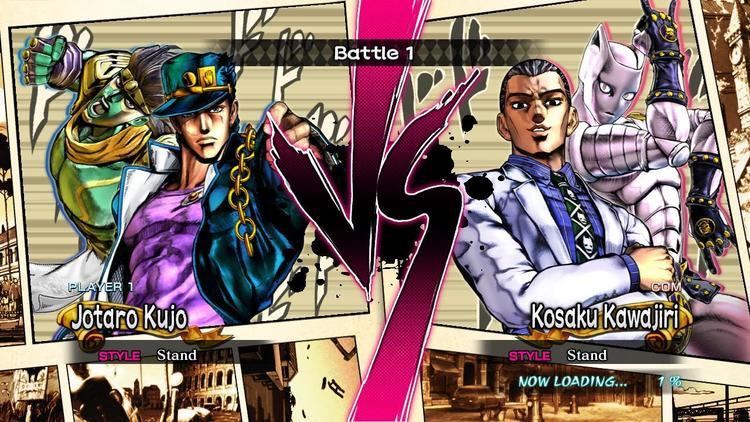
Each of the game's stages, based on locations from the manga, feature battleground gimmicks which trigger when a character is knocked down onto a certain area, causing hazards such as a speeding chariot to run characters down or a rain of poison dart frogs to induce a poison status. There are also Dramatic Finishes, which trigger when a player is defeated by a super move in a certain area, replicating scenes from the manga.
Game modes
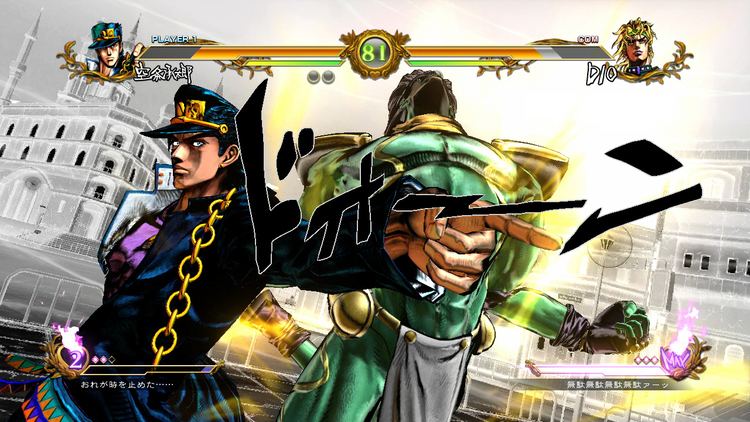
All Star Battle features many different game modes. Story Mode is a single player option that allows players to go through an original story inspired by the eight parts of the manga. Players control the protagonists of the series, partly reenacting various scenes from the manga. Winning Scenarios awards the player Gold that they can use to buy Support Items, items that change certain conditions in battle, for Story Mode or in the Gallery Shop. After completing a Part's Story Mode once, a new option known as Another Battle opens up, allowing the player to play as the opposite character in the Story Mode matches, taking on the role of the series' antagonists. There are also a series of Secret Missions in each Story Mode Scenario, such as requiring the player to hit the opponent with a particular move or not losing a match. These award additional Gold as well as artwork and character models not accessible from the Gallery Shop. It is only through Story Mode that additional on-disc characters are unlocked through play. However, if a player purchases any downloadable characters, new Story Mode Scenarios will open.
Campaign Mode is an online mode where players can unlock items known as Customize Medals which allow them to change the preset appearance and mannerisms of their unlocked characters. Players either fight a Vision, a computer opponent customized by another player, or a Boss character, which appears usually less than 7% of the time. While all matches result in the player winning the Taunt, Victory, or Sound Effect Medals, only the Bosses possess the rarer Additional Color, Special Costume, and Additional Line Medals. To enter a match, a player must spend a unit of Energy, similar to the number of lives available in social network games. Boss characters possess an HP bar used outside of battle, depleted by a set amount after every victory or loss. This amount can be multiplied through the expenditure of Energy, with more Medals awarded in a shorter period of time. Once the player encounters the Boss through random chance, they are given a 10-minute window to use another Energy to encounter the Boss, again, at a 100% chance or else the encounter rate is reset. Once the Boss's HP reaches 0, the player will be awarded a Special Costume Medal and the Boss's HP will be restored for the next encounter. Campaign Mode also features several random events that can assist the player in either Vision or Boss matches, such as Rudol von Stroheim depleting the opponent's health bar, Cioccolata increasing the rate at which Boss HP is depleted when more Energy is used, or Ken Oyanagi offering the player a game of rock-paper-scissors to confirm that the next match will be a Boss match of the player's choice. Several of these events may require Energy, such as with Ken Oyanagi where the player can spend one or two Energy levels to remove one or two of Ken's options in the rock-paper-scissors game, ensuring a win. Energy was initially restored at a rate of one unit per 20 minutes, and at points a special campaign was run to increase the restoration process to 5 minutes. In the October 11, 2013, patch, the five-minute restoration was made a permanent aspect of the game. The player can also receive Energy as a result of a random event, or it can be purchased via microtransactions. There are also several Support Items in the game, awarded through random events, as the player improves their Campaign Score, or via microtransaction. The Campaign Score also serves to unlock customization options for the Player Card.
Versus Mode features both local offline play and online play in either free battles or ranked matches which affect a player's Battle Score. Customize Mode allows players to utilize the Customize Medals won through Campaign Mode to change their character's taunt phrases, taunt poses, and winning poses, as well as customize their own Vision other players compete against in Campaign Mode. There is also an option to modify the quote that appears on the Player Card used in Versus Mode online play, with new quotes won through increasing one's Campaign Mode Campaign Score, and an option to view the Player Cards of other players encountered through Versus Mode. Gallery Mode displays all of the 2D artwork, 3D character models, sound test, and "JoJo's Dictionary", a collection of trivia relating to characters in the game. The mode also features a Gallery Shop where the player purchases entries for the other Gallery Mode options. In addition, the game features a standard Practice Mode and an Options Mode. The Western version of the game adds an Arcade Mode, in which the player faces up against eight computer-controlled opponents. At some times Arcade Mode will become a "Harvest" mode when connected to the internet, awarding more Gold at the end of the matches.
Battle Styles
Characters each possess one of five main Battle Styles (バトルスタイル, Batoru Sutairu), reflecting the origins of own abilities from the manga's continuity, although some characters may possess aspects of the other Battle Styles. A sixth battle style is exclusive to Baoh's Ikuro Hashizawa.
Both Vampires and the Pillar Men are limited to nighttime or indoor stages until certain qualifications are met in Story Mode. They also all possess a unique animation for the Situation Finish on Part 3's DIO's Mansion stage.
Several characters possess unique additional status bars or icons. These include Guido Mista's available ammunition and members of Sex Pistols, Enrico Pucci's 14 Words to switch between Whitesnake and C-Moon, or Gyro's Steel Balls and Rotation energy. Characters from Part 7 Steel Ball Run have a shared unique status bar which represents how many parts of the Corpse (遺体, Itai) they possess; for example, one piece allows Gyro to use the Scan move, two pieces allow Johnny to automatically restore his fingernail bullets (otherwise requiring a special move to activate), while all three pieces enable Valentine to use D4C -Love Train- which makes him immune to projectile attacks, particularly those from Johnny and Gyro.
Characters
There are a total of 32 playable characters available on the game disc, with 14 unlocked from the start. Additional characters were made available as part of DLC campaigns, eventually bringing the total number of characters to 41. One of these downloadable characters, Ikuro Hashizawa, makes a guest appearance from Hirohiko Araki's earlier manga series, Baoh.
There are many non-playable characters that appear throughout the game. Some, such as Robert E.O. Speedwagon (voiced by Yōji Ueda, reprising his role from the television series), feature prominently in the menu UI. Others can be found in the Story Mode narration, random events in Campaign Mode, the Stage Gimmicks and Situation Finishes, or as options in the Player Card quotes. Dialogue for all characters in the game are quotes from the original manga or related works, such as the light novels.
Stages
The various stages in All Star Battle are all modeled after a particular scene in the manga.
Download content
Several downloadable content campaigns are planned for release, featuring additional playable characters for purchase as well as adding Customize Medals to be unlocked through Campaign Mode. The first online campaign "The Darkness That Haunts Morioh Town" (杜王町に巣食う闇, Moriō-chō ni Sukuu Yami) was made available at launch and features 144 Customize Medals to win and Yoshikage Kira and Shigekiyo Yangu as downloadable characters. The second online campaign "The Ferocious Beasts" (どう猛な野獣, Dōmō na Yajū) was released on September 12, 2013, adds an additional 128 Customize Medals and Iggy and Pannacotta Fugo as downloadable characters. The third campaign "The Ripple Masters" (波紋の達人, Hamon no Tatsujin) was released on September 26, 2013 and features an additional 128 Customize Medals as well as LisaLisa and Joseph Joestar (as he appears in Stardust Crusaders) as downloadable characters. The fourth campaign, titled "The Executioners of Terror" (恐怖の処刑人, Kyōfu no Shokeinin) featuring Vanilla Ice and Narsico Anasui as downloadable characters and another 126 medals. The fifth, and so far final campaign, titled "This! Is! Baoh!!" (これが!バオーだッ!!, Kore ga! Baō da!!) adds Ikuro Hashizawa as a downloadable character and another 127 Customize Medals. On December 3, 2013, Yoshikage Kira was made available for purchase for those who did not purchase the first editions of the video game. In addition, several new items were added to the Campaign Mode store that were previously shown in the game but were unobtainable. A week later, an additional Campaign Data Pack was released, changing the HP and encounter rates of all bosses, and changing the game's splash screen to its default variation.
In addition to these standard download campaigns, a series of special download codes were made available throughout the game's release. The first was a limited edition download code included for people who pre-ordered All Star Battle from the HMV via the Loppi kiosks at Lawson stores throughout Japan that unlocked special taunt phrases for the Josuke Higashikata (4), Okuyasu Nijimura, and Koichi Hirose characters. Another such code was included in the game's official guide book, but or a special victory phrase for Jotaro Kujo. A third download code for a special costume for Johnny Joestar was included in Banpresto's Steel Ball Run Ichiban Kuji campaign for people who won their local shop's daily Last One prize.
December 19, 2013, saw the beginning of a collaboration with the HD version of JoJo's Bizarre Adventure: Heritage for the Future, allowing players to download alternate costumes for Jotaro Kujo and Polnareff based on promotional artwork for the original arcade game.
All Star Battle League
As a way to promote the video game, Namco Bandai and CyberConnect2 performed a series of Livestream broadcasts called JoJo's Bizarre Adventure: All Star Battle League (ジョジョの奇妙な冒険 オールスターバトルリーグ, JoJo no Kimyō na Bōken Ōru Sutā Batoru Rīgu) during July and August 2013. During the broadcasts, Bandai Namco producer Noriaki Niino, CyberConnect2 producer Hiroshi Matsuyama, and comedian and JoJo fan Kendo Kobayashi hosted a tournament between the computer controlled characters to display gameplay. There were six sets of preliminary matches where characters were grouped together randomly, with the top two characters out of each group moving onto the quarter finals. A seventh group consisting of the last characters to be announced and a fan favorite from the previous groups was run, with the winner joining the other twelve characters. Several fan favorite characters were included as seats. The sixteen characters then were put into a tournament bracket, with the winner of the All Star Battle League ultimately being DIO. To commemorate the victory, a special PlayStation 3 theme featuring DIO and his Stand The World was made available.
Development
All Star Battle was first announced in July 2012. The game is built with an engine known as the JoJo Shading Requiem (JOJO・シェーディング・レクイエム, JoJo Shēdingu Rekuiemu), which gives it a stylized manga look.
The game is sold as both a standard edition and a limited edition "Gold Experience Box" (黄金体験BOX(ゴールド・エクスペリエンスボックス), Gōrudo Ekusuperiensu Bokkusu), which contains a gold plate etching of Giorno Giovanna and his Stand Gold Experience, a figure statue of Jotaro Kujo and his Stand Star Platinum, and the game's original soundtrack on a CD resembling the power of the Stand Whitesnake. First edition pressings of both the standard and limited editions include a memo pad designed to look like Part 4 supporting character Hayato Kawajiri under the thrall of Rohan Kishibe's Heaven's Door Stand and a download code to access the character Yoshikage Kira. In the seventh promotional video for the games, Namco Bandai announced it would be providing all downloadable characters for half-price through September 25, 2013, due to the preorders. At the 2013 Tokyo Game Show, Namco Bandai made another announcement that they would be continuing this half-price campaign through at least Campaign 3; in an announcement for a new patch, it was revealed the campaign would run through December 2, 2013.
On September 19, 2013, Namco Bandai Games announced it would be releasing the game internationally in 2014, with a release date of Spring 2014 announced for Europe. The game will have localized names for some of the characters, with the publisher working with Shueisha to ensure names fit with Hirohiko Araki’s intentions "while not offending any party", and will match with the North American and European releases of the recent anime series for consistency. In late January 2014, it was announced that All Star Battle would be given a limited physical release in the United States through Amazon.com and ClubNamco.com, as well a release on the PlayStation Network. The game will also include a new Arcade Mode not found in the Japanese release featuring the player fighting eight CPU-controlled characters that will occasionally enter a "Harvest" mode to connect online and get more gold (the in-game currency). The release also includes all of the patches released for the Japanese version. The European release of the games will also feature a limited edition release, dubbed the "Exquisite Edition", which in addition to a physical copy of the game includes a figurine of Jotaro Kujo and Star Platinum studded with 6000 Swarovski crystals, which will receive a limited release and be auctioned off for charity through GamesAid. The auction ended on April 5, 2014, at GB£687. Another Exquisite Edition was sold at auction during the 2014 Anime Expo, with proceeds going to a local children's hospital.
Reception
Famitsu gave All Star Battle a perfect 40/40. The game was a winner in the "Future" division of the 2012 "Japan Game Awards". The game sold over 500,000 pre-orders, and Namco Bandai producer Noriaki Niino thanked the fans of the manga series for making the game such a success. In an import review, Kotaku praised the game for its imagination and faithfulness to the source material, but acknowledged glaring problems such as balance issues and Campaign Mode's structure that leans towards microtransaction-type social games. In response to such criticisms domestically, CyberConnect2 released an update to the system to address balance problems on September 11, 2013, with a second update to further address these issues for October 2013; the recharge rate for Energy in Campaign Mode was also sped up to five minutes from 20 minutes starting September 6, 2013, without any announced final date and several items that would have been paid for were made free. Two more character balancing updates were released up through November 2013, during which time the Campaign Mode was updated to make five minutes the new permanent recharge rate. As of March 31, 2014, the game has shipped 700,000 copies.
